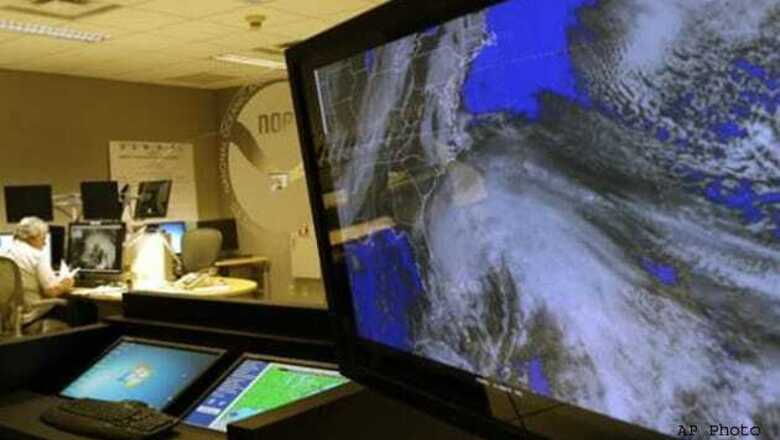
views
North Carolina: Hurricane Sandy could be the biggest storm to hit the United States mainland when it comes ashore on Monday night, bringing strong winds and dangerous flooding to the East Coast from the mid-Atlantic states to New England, forecasters said on Sunday.
Sandy could have a brutal impact on major cities in the target zone like Boston, New York, Washington, Baltimore, Philadelphia, one of the most densely populated regions of the country.
New York City's subway, bus and train service will be suspended on Sunday evening, which could bring the country's financial nerve center to a standstill. The major Wall Street exchanges said they planned to open as usual on Monday because they have alternate facilities they can use.
The Obama administration estimated it could affect 50 million people, and the storm was already disrupting transportation systems. More than 700 flights, including international ones, were cancelled on Sunday and nearly 2,500 more were cancelled for Monday, FlightAware.com said.
Forecasters said Sandy was a rare, hybrid "super storm" created by an Arctic jet stream wrapping itself around a tropical storm, possibly causing up to 12 inches (30 cm) of rain in some areas, as well as heavy snowfall inland. "The size of this alone, affecting a heavily populated area, is going to be history making," said Jeff Masters, a hurricane specialist who writes a blog posted on the Weather Underground (www.wunderground.com)
New Jersey casinos were ordered to close. New Jersey officials were weighing whether to shut down that state's bus and rail systems, and emergency officials warned of widespread power outages that could last for days.
"We're just asking people to be patient and be ready for a long haul. But we have a very aggressive power restoration program in place and I think we're ready," Virginia Governor Robert McDonnell told the CNN program "State of the Union."
On its current projected track, Sandy is most likely to make landfall between in the New York/New Jersey area and head inland to Philadelphia and Pennsylvania, forecasters said.
Forecasters at the National Hurricane Center in Miami said the storm's impact would be felt far from the center. While Sandy's 75 mph (120 kph) winds were not overwhelming for a hurricane, its width made it exceptional.
Hurricane-force winds extended 175 miles (280 km) from its center while its lesser tropical storm-force winds spanned 1,040 miles (1,670 km) in diameter. It was not expected to strengthen but was expected to broaden.
At high tide, the storm could bring a surge of seawater up to 11 feet (3.4 meters) above normal levels to Long Island Sound and New York Harbor. "Given the large wind field associated with Sandy, elevated water levels could span multiple tide cycles, resulting in repeated and extended periods of coastal and bayside flooding," the forecasters said.
Sandy was centered about 260 miles (420 km) southeast of Cape Hatteras, North Carolina, early on Sunday, the hurricane center said. The storm pushed seawater up over the barrier islands off North Carolina known as the Outer Banks. "It's flooded all over the village," longtime Ocracoke Island resident Kathleen O'Neal told Reuters via telephone. "I would say between a foot and two feet of water."
Sandy was moving over the Atlantic parallel to the US coast at 10 mph (17 kph), but was forecast to make a tight westward turn toward the US coast on Sunday night. Tropical storm conditions were spreading across the coast of North Carolina on Sunday morning and gale-force winds are forecast to begin affecting Washington, New York and southern New England by Monday.
Sandy could be the largest storm to hit the United States, according to the National Oceanic and Atmospheric Administration's (NOAA) website. Sandy killed at least 66 people as it made its way through the Caribbean islands, including 51 in Haiti, mostly from flash flooding and mudslides, according to authorities.
The approaching storm forced a change of plans for both presidential candidates ahead of the November 6 election. The White House said President Barack Obama canceled a campaign appearance in Virginia on Monday and another stop in Colorado on Tuesday, and will instead monitor the storm from Washington.
Republican challenger Mitt Romney rescheduled campaign events planned for Virginia on Sunday and was flying to Ohio instead. All along the US coast, worried residents packed stores, buying generators, candles, food and other supplies in anticipation of power outages. Some local governments announced schools would be closed on Monday and Tuesday. "They're freaking out," said Joe Dautel, a clerk at a hardware store in Glenside, Pennsylvania. "I'm selling people four, five, six packs of batteries - when I had them."


















Comments
0 comment